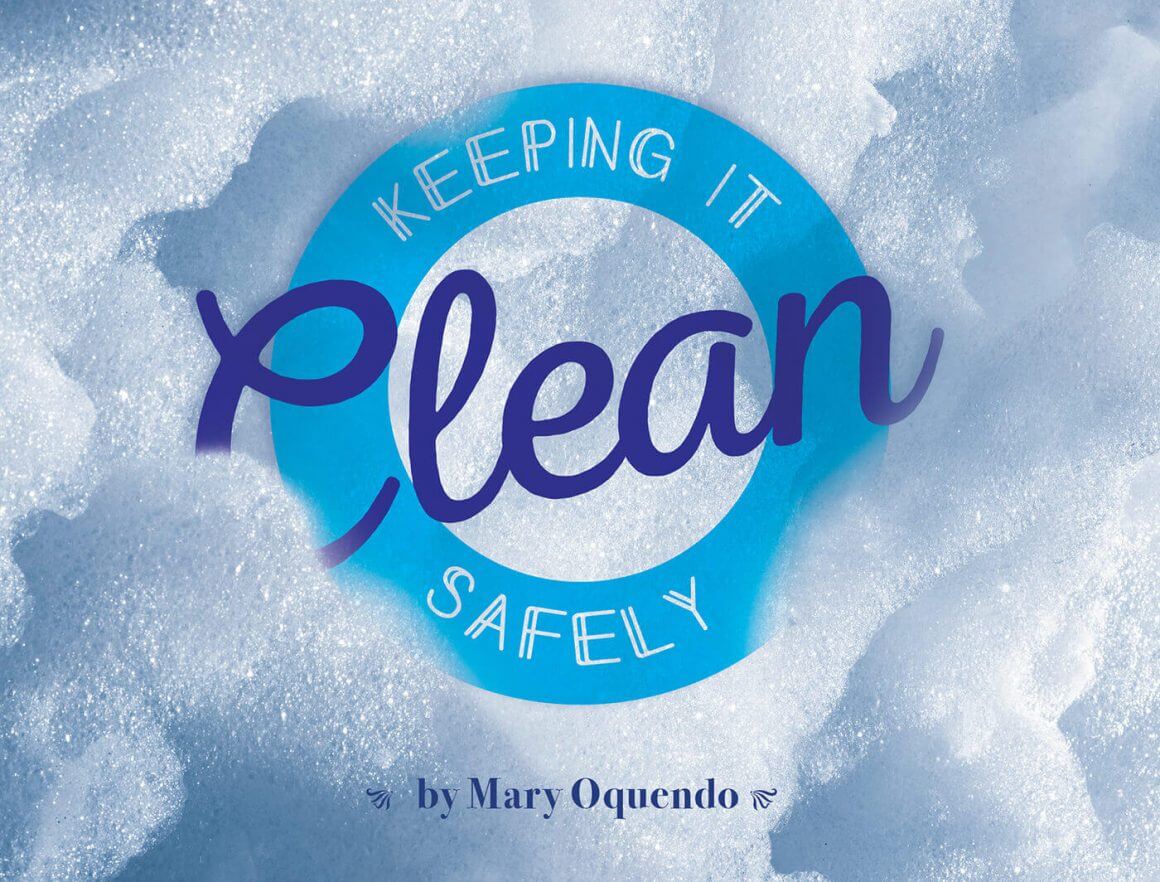By Mary Oquendo
At the same time we want to keep our facilities clean and sanitary, we do not want to breathe in noxious chemicals several times a day. There are many studies that link long-term use of such products to chronic health concerns. However, we still have many choices.
Differentiating Between Cleaning & Disinfecting
Cleaning removes the most common vectors of transmission of contagions: the biological. Biological include hair, dander, dirt, blood, urine, and feces. Contagions are bacteria, viruses, and spores that have the potential to spread disease. Cleaners do not necessarily disinfect. Disinfecting disables the contagion to prevent cross contamination. But disinfectants work better on clean surfaces.
Store Bought Cleaning Products
As cleaning products are not for human consumption, the terms “Green” or “Natural” may not mean much as the terms are not regulated. There may be “greenwashing” going on the label. Greenwashing is a term used to describe a product as natural and healthy, when in reality it’s not. It sounds good, but that’s it. Nothing more than marketing. And to top it off, US manufacturers are not required by law to list all ingredients. Sound familiar? It’s important to read labels and visit websites. The EPA has a program called Safer Choice. In order to be on their list, manufacturers must follow strict guidelines. You can look up companies at https://www.epa.gov/saferchoice/products to easily find safer alternatives.
Undiluted 70% Rubbing Alcohol
Rubbing alcohol is considered a solvent and dissolves dirt and oils. It is used in hospitals. Even though cats cannot metabolize alcohol, it dries almost instantly and without residue, therefore it can be used around cats once the alcohol has dried. If used as a disinfectant, the surface must remain wet for 10 minutes.
Portable Steam Cleaners
The reservoir is filled with water and the steam cleaner heats the water hot enough to produce steam. Unlike many liquid cleaners, a steam cleaner can get into porous surfaces such as grout and floor and wall seams.
50/50 Vinegar to Water Mix
Vinegar is mildly acidic and as such has anti-bacterial properties, however, the EPA does not list it as a disinfectant. It is my cleaner of choice. Vinegar is also abrasive and breaks up dirt and oils. If you want it to smell better, then add some orange or lemon rinds to the bottle. You can add essential oils as well, but make sure cats do not have access to those surfaces. Oils may leave a residue that can be absorbed through cats’ pads.
Hydrogen Peroxide
One cup of hydrogen peroxide to a gallon of water can be used as a cleaner. However, hydrogen peroxide is listed as antibacterial and antiviral from the EPA. In order to take advantage of those disinfecting properties it must:
Be undiluted in the brown bottle. Once opened or used in clear containers will start the degradation process. Hydrogen peroxide will turn into water.
Remain on the surface for
20 minutes.
Soap
Plain old soap and water, as it removes the biological, may cause transmission of disease when washing our hands and rinsing down the tub in between pets.
Norwex Microfiber Cloths
These are specially treated cloths that lift dirt instead of moving it around. They just require spraying the area first with water, then wiping with the cloth. The manufacturer makes antibacterial and antiviral claims as silver is used in the treatment process. But, I don’t know how accurate that is or for how long the cloths keep those properties. They do a great job of cleaning without the mess of paper towels. My van almost sparkles after using them. You cannot buy them at a store. Distributors sell them. Luckily there are many groomers who are distributors. A request on any of the grooming forums will turn up several.
Air Cleaners
To efficiently clean the air without neurochemicals; air circulation fans, plants, and salt lamps are effective. Effective air circulation needs intake and outtake fans. The larger the facility, the more complicated this becomes and you may need to hire an HVAC company to install a system. Plants do their thing by releasing oxygen and absorbing VOC’s (volatile organic compounds.) VOC’s are the harsh chemicals found in paints, aerosols, and certain cleaners. Salt lamps neutralize positively charged bacteria, dust, and pollen when they are heated by lamp or candle. The heat attracts water in the air and separates the salt ions. There are now more loose negatively charged chloride ions that can bind with those positively charged bacteria in the air. That’s the flaking you see on the counter around salt lamps.
Enzymatic Cleaners
These spray cleaners utilize enzymes to break down bacteria and dirt. In addition, they penetrate porous surfaces such as grout, floor and wall seams.
Essential Oils
Essential oils such as Lemon, Wild Orange, and Eucalyptus are great for cleaning. You can find many cleaning recipes online. Essential oils will leave a residue when dried. They should not be used around cats, as cats cannot metabolize most essential oils.
Do I personally use Quats (quaternary ammonium products such as Dakil) or bleach? Absolutely, when the situation calls for it. However, for day to day cleaning I rely on natural cleaners with or without essential oils to protect my long term health. ✂
Resources
http://cleaningbusinesstoday.com/blog/hydrogen-peroxide-vinegar-a-disinfecting-duo
https://www.ncbi.nlm.nih.gov/pmc/articles/PMC3018511/
http://www.healthline.com/health/chlorine-poisoning#Overview1
http://www.cnn.com/2016/07/01/health/everyday-chemicals-we-need-to-reduce-exposure-to/
